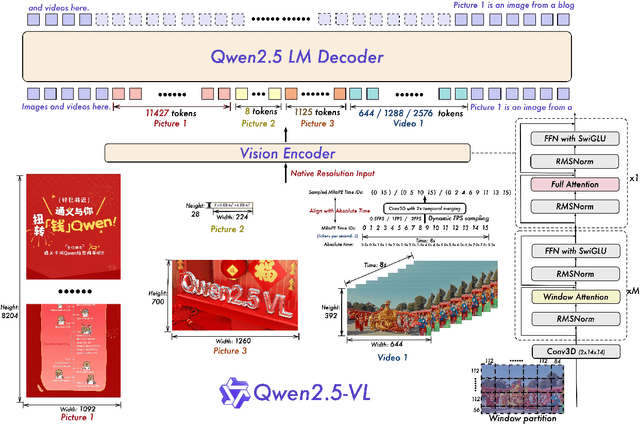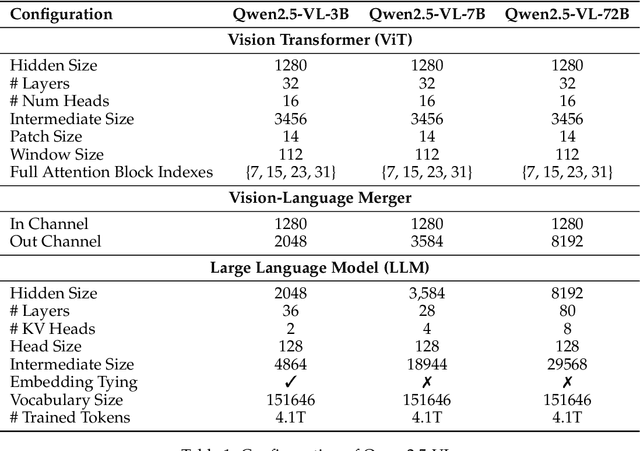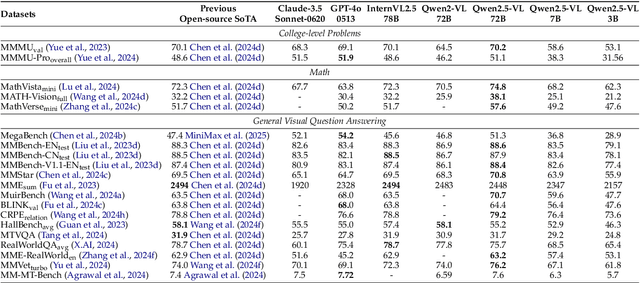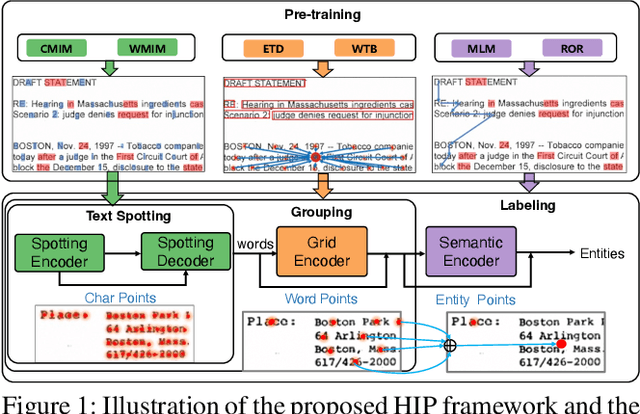Zhibo Yang
DocThinker: Explainable Multimodal Large Language Models with Rule-based Reinforcement Learning for Document Understanding
Aug 12, 2025Abstract:Multimodal Large Language Models (MLLMs) have demonstrated remarkable capabilities in document understanding. However, their reasoning processes remain largely black-box, making it difficult to ensure reliability and trustworthiness, especially in high-stakes domains such as legal, financial, and medical document analysis. Existing methods use fixed Chain-of-Thought (CoT) reasoning with supervised fine-tuning (SFT) but suffer from catastrophic forgetting, poor adaptability, and limited generalization across domain tasks. In this paper, we propose DocThinker, a rule-based Reinforcement Learning (RL) framework for dynamic inference-time reasoning. Instead of relying on static CoT templates, DocThinker autonomously refines reasoning strategies via policy learning, generating explainable intermediate results, including structured reasoning processes, rephrased questions, regions of interest (RoI) supporting the answer, and the final answer. By integrating multi-objective rule-based rewards and KL-constrained optimization, our method mitigates catastrophic forgetting and enhances both adaptability and transparency. Extensive experiments on multiple benchmarks demonstrate that DocThinker significantly improves generalization while producing more explainable and human-understandable reasoning steps. Our findings highlight RL as a powerful alternative for enhancing explainability and adaptability in MLLM-based document understanding. Code will be available at https://github.com/wenwenyu/DocThinker.
MAER-Nav: Bidirectional Motion Learning Through Mirror-Augmented Experience Replay for Robot Navigation
Mar 31, 2025



Abstract:Deep Reinforcement Learning (DRL) based navigation methods have demonstrated promising results for mobile robots, but suffer from limited action flexibility in confined spaces. Conventional DRL approaches predominantly learn forward-motion policies, causing robots to become trapped in complex environments where backward maneuvers are necessary for recovery. This paper presents MAER-Nav (Mirror-Augmented Experience Replay for Robot Navigation), a novel framework that enables bidirectional motion learning without requiring explicit failure-driven hindsight experience replay or reward function modifications. Our approach integrates a mirror-augmented experience replay mechanism with curriculum learning to generate synthetic backward navigation experiences from successful trajectories. Experimental results in both simulation and real-world environments demonstrate that MAER-Nav significantly outperforms state-of-the-art methods while maintaining strong forward navigation capabilities. The framework effectively bridges the gap between the comprehensive action space utilization of traditional planning methods and the environmental adaptability of learning-based approaches, enabling robust navigation in scenarios where conventional DRL methods consistently fail.
Generative Compositor for Few-Shot Visual Information Extraction
Mar 21, 2025Abstract:Visual Information Extraction (VIE), aiming at extracting structured information from visually rich document images, plays a pivotal role in document processing. Considering various layouts, semantic scopes, and languages, VIE encompasses an extensive range of types, potentially numbering in the thousands. However, many of these types suffer from a lack of training data, which poses significant challenges. In this paper, we propose a novel generative model, named Generative Compositor, to address the challenge of few-shot VIE. The Generative Compositor is a hybrid pointer-generator network that emulates the operations of a compositor by retrieving words from the source text and assembling them based on the provided prompts. Furthermore, three pre-training strategies are employed to enhance the model's perception of spatial context information. Besides, a prompt-aware resampler is specially designed to enable efficient matching by leveraging the entity-semantic prior contained in prompts. The introduction of the prompt-based retrieval mechanism and the pre-training strategies enable the model to acquire more effective spatial and semantic clues with limited training samples. Experiments demonstrate that the proposed method achieves highly competitive results in the full-sample training, while notably outperforms the baseline in the 1-shot, 5-shot, and 10-shot settings.
Enhancing Deep Reinforcement Learning-based Robot Navigation Generalization through Scenario Augmentation
Mar 03, 2025



Abstract:This work focuses on enhancing the generalization performance of deep reinforcement learning-based robot navigation in unseen environments. We present a novel data augmentation approach called scenario augmentation, which enables robots to navigate effectively across diverse settings without altering the training scenario. The method operates by mapping the robot's observation into an imagined space, generating an imagined action based on this transformed observation, and then remapping this action back to the real action executed in simulation. Through scenario augmentation, we conduct extensive comparative experiments to investigate the underlying causes of suboptimal navigation behaviors in unseen environments. Our analysis indicates that limited training scenarios represent the primary factor behind these undesired behaviors. Experimental results confirm that scenario augmentation substantially enhances the generalization capabilities of deep reinforcement learning-based navigation systems. The improved navigation framework demonstrates exceptional performance by producing near-optimal trajectories with significantly reduced navigation time in real-world applications.
Beyond Visibility Limits: A DRL-Based Navigation Strategy for Unexpected Obstacles
Mar 03, 2025



Abstract:Distance-based reward mechanisms in deep reinforcement learning (DRL) navigation systems suffer from critical safety limitations in dynamic environments, frequently resulting in collisions when visibility is restricted. We propose DRL-NSUO, a novel navigation strategy for unexpected obstacles that leverages the rate of change in LiDAR data as a dynamic environmental perception element. Our approach incorporates a composite reward function with environmental change rate constraints and dynamically adjusted weights through curriculum learning, enabling robots to autonomously balance between path efficiency and safety maximization. We enhance sensitivity to nearby obstacles by implementing short-range feature preprocessing of LiDAR data. Experimental results demonstrate that this method significantly improves both robot and pedestrian safety in complex scenarios compared to traditional DRL-based methods. When evaluated on the BARN navigation dataset, our method achieved superior performance with success rates of 94.0% at 0.5 m/s and 91.0% at 1.0 m/s, outperforming conservative obstacle expansion strategies. These results validate DRL-NSUO's enhanced practicality and safety for human-robot collaborative environments, including intelligent logistics applications.
OmniParser V2: Structured-Points-of-Thought for Unified Visual Text Parsing and Its Generality to Multimodal Large Language Models
Feb 22, 2025Abstract:Visually-situated text parsing (VsTP) has recently seen notable advancements, driven by the growing demand for automated document understanding and the emergence of large language models capable of processing document-based questions. While various methods have been proposed to tackle the complexities of VsTP, existing solutions often rely on task-specific architectures and objectives for individual tasks. This leads to modal isolation and complex workflows due to the diversified targets and heterogeneous schemas. In this paper, we introduce OmniParser V2, a universal model that unifies VsTP typical tasks, including text spotting, key information extraction, table recognition, and layout analysis, into a unified framework. Central to our approach is the proposed Structured-Points-of-Thought (SPOT) prompting schemas, which improves model performance across diverse scenarios by leveraging a unified encoder-decoder architecture, objective, and input\&output representation. SPOT eliminates the need for task-specific architectures and loss functions, significantly simplifying the processing pipeline. Our extensive evaluations across four tasks on eight different datasets show that OmniParser V2 achieves state-of-the-art or competitive results in VsTP. Additionally, we explore the integration of SPOT within a multimodal large language model structure, further enhancing text localization and recognition capabilities, thereby confirming the generality of SPOT prompting technique. The code is available at \href{https://github.com/AlibabaResearch/AdvancedLiterateMachinery}{AdvancedLiterateMachinery}.
Qwen2.5-VL Technical Report
Feb 19, 2025



Abstract:We introduce Qwen2.5-VL, the latest flagship model of Qwen vision-language series, which demonstrates significant advancements in both foundational capabilities and innovative functionalities. Qwen2.5-VL achieves a major leap forward in understanding and interacting with the world through enhanced visual recognition, precise object localization, robust document parsing, and long-video comprehension. A standout feature of Qwen2.5-VL is its ability to localize objects using bounding boxes or points accurately. It provides robust structured data extraction from invoices, forms, and tables, as well as detailed analysis of charts, diagrams, and layouts. To handle complex inputs, Qwen2.5-VL introduces dynamic resolution processing and absolute time encoding, enabling it to process images of varying sizes and videos of extended durations (up to hours) with second-level event localization. This allows the model to natively perceive spatial scales and temporal dynamics without relying on traditional normalization techniques. By training a native dynamic-resolution Vision Transformer (ViT) from scratch and incorporating Window Attention, we reduce computational overhead while maintaining native resolution. As a result, Qwen2.5-VL excels not only in static image and document understanding but also as an interactive visual agent capable of reasoning, tool usage, and task execution in real-world scenarios such as operating computers and mobile devices. Qwen2.5-VL is available in three sizes, addressing diverse use cases from edge AI to high-performance computing. The flagship Qwen2.5-VL-72B model matches state-of-the-art models like GPT-4o and Claude 3.5 Sonnet, particularly excelling in document and diagram understanding. Additionally, Qwen2.5-VL maintains robust linguistic performance, preserving the core language competencies of the Qwen2.5 LLM.
SceneVTG++: Controllable Multilingual Visual Text Generation in the Wild
Jan 07, 2025



Abstract:Generating visual text in natural scene images is a challenging task with many unsolved problems. Different from generating text on artificially designed images (such as posters, covers, cartoons, etc.), the text in natural scene images needs to meet the following four key criteria: (1) Fidelity: the generated text should appear as realistic as a photograph and be completely accurate, with no errors in any of the strokes. (2) Reasonability: the text should be generated on reasonable carrier areas (such as boards, signs, walls, etc.), and the generated text content should also be relevant to the scene. (3) Utility: the generated text can facilitate to the training of natural scene OCR (Optical Character Recognition) tasks. (4) Controllability: The attribute of the text (such as font and color) should be controllable as needed. In this paper, we propose a two stage method, SceneVTG++, which simultaneously satisfies the four aspects mentioned above. SceneVTG++ consists of a Text Layout and Content Generator (TLCG) and a Controllable Local Text Diffusion (CLTD). The former utilizes the world knowledge of multi modal large language models to find reasonable text areas and recommend text content according to the nature scene background images, while the latter generates controllable multilingual text based on the diffusion model. Through extensive experiments, we respectively verified the effectiveness of TLCG and CLTD, and demonstrated the state-of-the-art text generation performance of SceneVTG++. In addition, the generated images have superior utility in OCR tasks like text detection and text recognition. Codes and datasets will be available.
CC-OCR: A Comprehensive and Challenging OCR Benchmark for Evaluating Large Multimodal Models in Literacy
Dec 03, 2024Abstract:Large Multimodal Models (LMMs) have demonstrated impressive performance on recognizing document images with natural language instructions. However, it remains unclear to what extent capabilities in literacy with rich structure and fine-grained visual challenges. The current landscape lacks a comprehensive benchmark to effectively measure the literate capabilities of LMMs. Existing benchmarks are often limited by narrow scenarios and specified tasks. To this end, we introduce CC-OCR, a comprehensive benchmark that possess a diverse range of scenarios, tasks, and challenges. CC-OCR comprises four OCR-centric tracks: multi-scene text reading, multilingual text reading, document parsing, and key information extraction. It includes 39 subsets with 7,058 full annotated images, of which 41% are sourced from real applications, being released for the first time. Furthermore, we evaluate nine prominent LMMs and reveal both the strengths and weaknesses of these models, particularly in text grounding, multi-orientation, and hallucination of repetition. CC-OCR aims to comprehensively evaluate the capabilities of LMMs on OCR-centered tasks, driving advancement in LMMs.
HIP: Hierarchical Point Modeling and Pre-training for Visual Information Extraction
Nov 02, 2024



Abstract:End-to-end visual information extraction (VIE) aims at integrating the hierarchical subtasks of VIE, including text spotting, word grouping, and entity labeling, into a unified framework. Dealing with the gaps among the three subtasks plays a pivotal role in designing an effective VIE model. OCR-dependent methods heavily rely on offline OCR engines and inevitably suffer from OCR errors, while OCR-free methods, particularly those employing a black-box model, might produce outputs that lack interpretability or contain hallucinated content. Inspired by CenterNet, DeepSolo, and ESP, we propose HIP, which models entities as HIerarchical Points to better conform to the hierarchical nature of the end-to-end VIE task. Specifically, such hierarchical points can be flexibly encoded and subsequently decoded into desired text transcripts, centers of various regions, and categories of entities. Furthermore, we devise corresponding hierarchical pre-training strategies, categorized as image reconstruction, layout learning, and language enhancement, to reinforce the cross-modality representation of the hierarchical encoders. Quantitative experiments on public benchmarks demonstrate that HIP outperforms previous state-of-the-art methods, while qualitative results show its excellent interpretability.
 Add to Chrome
Add to Chrome Add to Firefox
Add to Firefox Add to Edge
Add to Edge